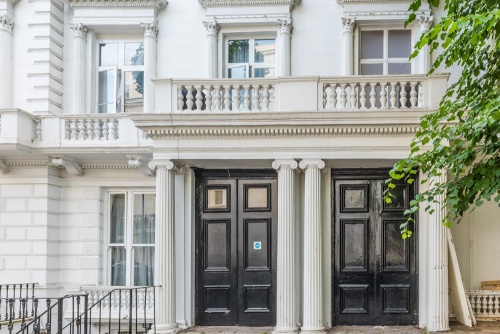
When the Metropolitan Line of London's underground network was built in the 1860s the route passed through the quiet, tree-lined streets of Bayswater, just north of Kensington Gardens.
Rather than bore the underground tunnels under the existing streets, the railway engineers used the 'cut and cover' technique; they dug deep channels through the city and covered them up again to create underground tunnels. Most of the properties demolished to make way for the railway tunnels were rebuilt. Most, but not all.
One exception to the rule created one of London's most peculiar oddities, a pair of false-fronted houses on elegant Leinster Gardens in Bayswater. When the Metropolitan Line passed through Leinster Gardens, linking Paddington and Bayswater stations, numbers 23 and 24 were pulled down to allow room for construction. But rather than rebuild them, the railway company created a pair of false fronts; elegant facades that looked exactly like their five-storey neighbours but were, in fact, just 5 feet thick (1.5m).
But why?

The answer lies in a very practical concern. Locomotives drawing the underground railway ran on steam created by burning coal. The locomotives were fitted with condensers to capture most of the smoke and condensation from the steam. They needed open-air sections of track to safely vent the built-up steam and smoke so that it would not contaminate the underground tunnels and make the air too foul to use.
One open-air section used to vent steam and smoke was at Leinster Gardens. Rather than letting residents see this unsightly process, the railway company erected house facades at 23-24 Leinster Garden. They planted trees and painted in the upper storey windows to make it seem as if the houses were real.
The only clue that you are looking at false frontage comes from the fact that the front doors have no letterboxes, and if you look closely you will see the painted windows are not sporting curtains like their neighbours. As disguises go, it is masterful. You simply wouldn't know that the houses you are passing by are anything other than ordinary residences.

They have the same balustraded balconies, the same elegant neo-classical designs with Ionic and Corinthian columns, sash windows and detailed cornices as nearby houses along the terrace. Another minor giveaway is that neither of the houses has a visible house number. You have to infer the house numbers from the neighbouring properties.
Note that the doors of numbers 23 and 24 are not side by side (I've seen this error in other articles about the properties). Number 23 is painted black and is side by side with another black-painted door belonging to the neighbouring hotel to the south. Number 24 is painted white and is 'doubled' with another white painted door to the north.
The houses have been used for practical jokes ever since they were built, with gullible delivery drivers being sent to make deliveries to the non-existent properties. On one occasion in the 1930s fraudsters sold tickets to a charity ball at 10 guineas apiece. Members of high society showed up at the door in their elegant evening wear only to discover they'd been duped and there was no ball - nor a venue.
More recently, pizza delivery companies have been sent to the houses so many times that they know not to be taken in. Other pranks have included sending taxis to pick up non-existent fares.
23/24 Leinster Gardens gained a bit of cult status after the facade was used in the hit BBC TV series Sherlock, appearing in the 'His Last Vow' episode, when Mary Hudson's face was projected onto the false fronts.
Transport for London maintains the houses.

Getting There
Leinster Gardens is equidistant from Bayswater (Circle and District Lines) and Queensway (Central Line). From Queensway tube station entrance cross Queensway and follow Bayswater for 4 blocks to Leinster Terrace. Turn left onto Leinster Terrace and walk one block north to where it becomes Leinster Gardens. Numbers 23-24 are on your left, immediately beyond the Henry VIII Hotel.
From Bayswater tube station turn left and follow Queensway to Portchester Gardens. Turn right on Portchester Gardens and go straight on for 3 blocks. The street becomes Leinster Place. Go straight along Leinster Place and turn right onto Leinster Gardens. Numbers 23 and 24 are at the end of the block on your left.
It should take less than five minutes easy walk from either Bayswater or Queensway tube stations.
Now, just to be confusing, the Henry VIII Hotel has a brass plate on the door saying number 23 and its official address is 23 Leinster Gardens. The hotel is very real and is NOT a false-fronted property.
About 23-24 Leinster Gardens
Address: 23-24 Leinster Gardens,
London,
Greater London,
England, W2 3BH
Attraction Type: Historic Building - Landmark
Location: At the southern end of Leinster Gardens, on the west side of the street. Easy access on foot from Bayswater and Queensway underground stations.
Location
map
OS: TQ261808
Photo Credit: David Ross and Britain Express
Nearest station: ![]() Bayswater - 0.2 miles (straight line) - Zone: 1
Bayswater - 0.2 miles (straight line) - Zone: 1
NEARBY HISTORIC ATTRACTIONS
Heritage Rated from 1- 5 (low to exceptional) on historic interest
Kensington Gardens - 0.4 miles (Park) ![]()
Kensington Palace - 0.5 miles (Historic House) ![]()
Alexander Fleming Laboratory Museum - 0.5 miles (Museum) ![]()
Albert Memorial - 0.7 miles (Historic Building) ![]()
Hyde Park - 0.9 miles (Park) ![]()
18 Stafford Terrace (Linley Sambourne House) - 1 miles (Historic Building) ![]()
Marble Arch - 1.1 miles (Historic Building) ![]()
Science Museum - 1.1 miles (Museum) ![]()
Nearest Holiday Cottages to 23-24 Leinster Gardens:
Waltham Abbey, Essex
Sleeps: 6
Stay from: £946.00 - 4358.00
Loughton, Essex
Sleeps: 5
Stay from: £800.00 - 3670.00
Leaves Green, Greater London
Sleeps: 6
Stay from: £847.00 - 3941.00
More self catering near 23-24 Leinster Gardens



